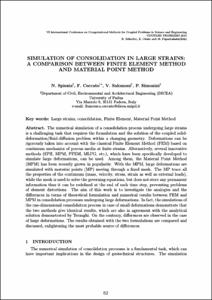Mostra el registre d'ítem simple
Simulation of consolidation in large strains: a comparison between finite element method and material point method
| dc.contributor.author | Spiezia, N. |
| dc.contributor.author | Ceccato, F. |
| dc.contributor.author | Salomoni, V. |
| dc.contributor.author | Simonini, P. |
| dc.date.accessioned | 2020-06-18T07:06:18Z |
| dc.date.available | 2020-06-18T07:06:18Z |
| dc.date.issued | 2015 |
| dc.identifier.isbn | 978-84-943928-3-2 |
| dc.identifier.uri | http://hdl.handle.net/2117/191007 |
| dc.description.abstract | The numerical simulation of a consolidation process undergoing large strains is a challenging task that requires the formulation and the solution of the coupled soliddeformation/fluid-diffusion problem within a changing geometry. Deformations can be rigorously taken into account with the classical Finite Element Method (FEM) based on continuum mechanics of porous media at finite strains. Alternatively, several innovative methods (SPH, MPM, PFEM, MLPG, etc.), which have been specifically developed to simulate large deformations, can be used. Among them, the Material Point Method (MPM) has been recently grown in popularity. With the MPM, large deformations are simulated with material points (MP) moving through a fixed mesh. The MP trace all the properties of the continuum (mass, velocity, stress, strain as well as external loads), while the mesh is used to solve the governing equations, but does not store any permanent information thus it can be redefined at the end of each time step, preventing problems of element distortions. The aim of this work is to investigate the analogies and the differences in terms of theoretical formulation and numerical results between FEM and MPM in consolidation processes undergoing large deformations. In fact, the simulations of the one-dimensional consolidation process in case of small deformations demonstrate that the two methods give identical results, which are also in agreement with the analytical solution demonstrated by Terzaghi. On the contrary, differences are observed in the case of large deformations. The results obtained with the two formulations are compared and discussed, enlightening the most probable source of differences. |
| dc.format.extent | 12 p. |
| dc.language.iso | eng |
| dc.publisher | CIMNE |
| dc.subject | Àrees temàtiques de la UPC::Matemàtiques i estadística::Anàlisi numèrica::Mètodes en elements finits |
| dc.subject.lcsh | Finite element method |
| dc.subject.lcsh | Coupled problems (Complex systems) -- Numerical solutions |
| dc.subject.other | Large strains, consolidation, Finite Element, Material Point Method |
| dc.title | Simulation of consolidation in large strains: a comparison between finite element method and material point method |
| dc.type | Conference report |
| dc.subject.lemac | Elements finits, Mètode dels |
| dc.rights.access | Open Access |
| local.citation.contributor | COUPLED VI |
| local.citation.publicationName | COUPLED VI : proceedings of the VI International Conference on Computational Methods for Coupled Problems in Science and Engineering |
| local.citation.startingPage | 82 |
| local.citation.endingPage | 93 |


